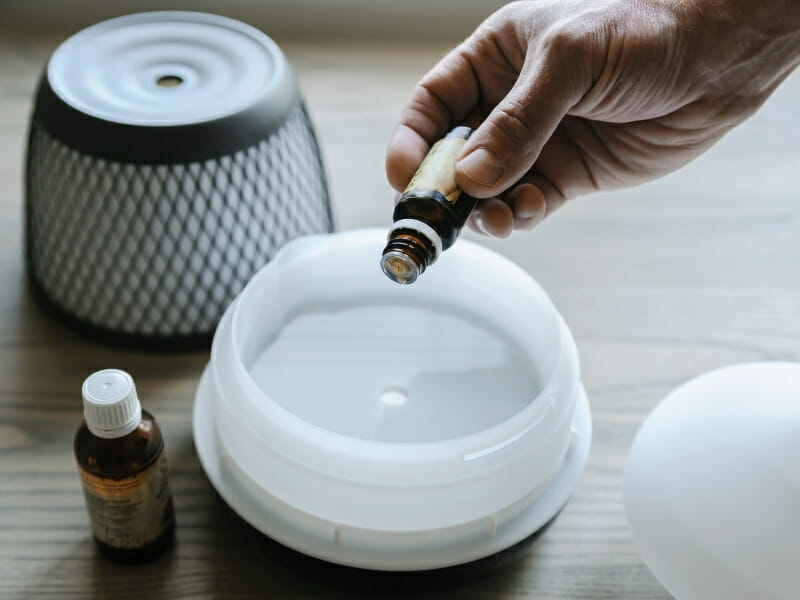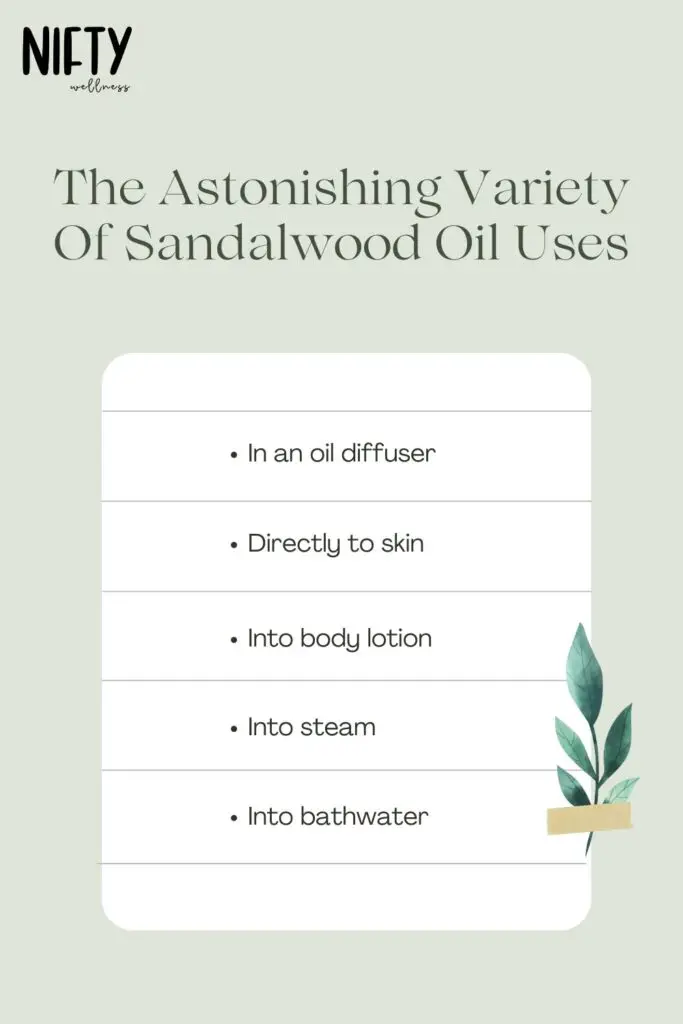It’s one of the most popular names in the oil world. And for good reason. Sandalwood essential oil benefits have been known and valued for centuries.
It’s known for its distinctive scent and strong medicinal properties, which is why you can find it in both fragrance products and alternative medicine practices. Personally, I have found its unique benefits to be truly invaluable in enhancing well-being and relaxation.
Today, we are going to explore the benefits of sandalwood oil and find out what makes it so invaluable around the world.
What Is Sandalwood Essential Oil

Sandalwood is a class of aromatic woods from the Santalum album species, with the main notable supply destinations being India and Australia.
The oil itself is extracted from the heartwood by distillation, which follows a process of boiling, steaming, condensation, and separation.
Sandalwood oil has been a popular ingredient in ayurvedic medicine, as well as traditional Chinese medicine. The main active ingredient is alpha-santalol, which has been shown to relieve a wide range of illnesses due to its pharmacological effects.
FUN FACT: Sandalwood trees grow slowly, and it takes around 15 years for the heartwood to become commercially valuable. The older the tree, the higher the quality of the oil.
What Does Sandalwood Smell Like
Sandalwood oil has a distinctive fragrance, which is often described as deep, woody, and floral. This powerful sandalwood scent has been prized in the perfume industry, aromatherapy, and soaps.
Personally, the enchanting aroma of sandalwood brings a sense of calm and tranquility to my surroundings, making it a go-to choice for enhancing relaxation and creating a soothing atmosphere. Its unique blend of earthiness and sweetness adds a personal touch to my aromatic preferences.
Check out our latest blog Essential Oils For Heart Health: Nurturing Your Heart Naturally. Elevate your heart health with our curated collection of essential oils.
Sandalwood Essential Oil Benefits

Traditionally, sandalwood has been used for a wide range of purposes due to its usefulness as a disinfectant, diuretic, expectorant, and stimulant. The aromatic scent has also made its way into the perfume industry as a useful base component.
In Ayurvedic systems, sandalwood is said to be used in the treatment of diarrhea, vomiting, poisoning, eye infections, and much more.
While there are so many to mention, here’s our list of sandalwood oil benefits and uses.
Helps Fight Bacteria


Research shows that sandalwood oil has demonstrated anti-microbial activity against many different strains of bacteria. Staphylococcus, Streptococcus, and many fungal yeasts, including Trichophyton, Microsporum, and Candida included.
It has also been reported to inhibit the Herpes simplex and influenza virus replications.
Calms The Nervous System

Sandalwood’s main active compound alpha-santalol provides relaxing physiological effects.
Studies indicate that massage with sandalwood oil reduced the level of arousal of the autonomic nervous system. And transdermal administration of the oil significantly decreased the eye-blink rate and pulse rate.
Anti-Inflammatory

East Indian Sandalwood oil has been proven to possess significant anti-inflammatory properties.
Research has shown that pediatric eczema and atopic dermatitis patients showed a 50% reduction in inflammation and severity due to topical application of sandalwood oil formulations.
Stabilizes Blood Pressure

With stress and anxiety being major triggers for hypertension, it’s crucial to avoid them altogether or find remedies to reduce their impact.
Studies show that sandalwood essential oil contains sedative hypotensive agents that help lower and stabilize blood pressure levels. The findings also corresponded with a distinct reduction of cortisol levels.
How To Use Sandalwood Oil


There are various ways of incorporating sandalwood oil into your aromatherapy routine at home.
Here’s a few to get you started:
- Use it in an oil diffuser
- Apply directly to your skin
- Add a few drops to your body lotion
- Add a few drops to the water while steaming your face
- Take a relaxing bath by adding a few drops to the bathwater
- Apply a few drops to the back of your neck before going to sleep to ensure a night of restful sleep
Note: Sandalwood oil is generally considered to be non-irritating, however, it is recommended to do a small patch test to determine if you have any existing sensitivity to the oil.
You can do it by applying it on the underside of your forearm. If any redness, itchiness, or swelling occurs, wash it off immediately and avoid using it directly on the skin.
In general, it is often suggested to dilute sandalwood oil with another carrier oil such as coconut, sweet almond, or jojoba oil.
Read our new blog How To Use Argan Oil For Eyebrows & 7 Other Benefits. From expert tips to real transformations, join us on a journey where each drop of argan oil brings you closer to brow bliss.
Conclusion

Centuries of therapeutic and medicinal use have demonstrated the exceptional ways in which sandalwood essential oil benefits the body. Besides, with its unique and pleasant scent, who wouldn’t want to try using it around their home?
In my personal experience, incorporating sandalwood oil has not only elevated my well-being but also added a touch of luxury to my daily routine.
Try out our tips on how to use the sandalwood essential oil, and let us know in the comments which benefits you noticed! And if you’re looking for another nifty oil, check out our article about amber essential oil.
Frequently Asked Questions (FAQs)
Is sandalwood essential oil safe for all skin types?
Yes, sandalwood essential oil is generally safe for all skin types. It possesses soothing properties that benefit sensitive skin and can help balance oil production in oily skin. However, it’s advisable to do a patch test before widespread use, especially for those with known allergies. If irritation occurs, discontinue use. Always dilute essential oils with a carrier oil before applying directly to the skin.
Can sandalwood essential oil be ingested?
No, it is not recommended to ingest sandalwood essential oil. Essential oils are highly concentrated and can be toxic if consumed inappropriately. Ingesting them may lead to adverse effects. Instead, use sandalwood oil for aromatherapy or dilute it with a carrier oil for topical application. If considering internal use for any purpose, consult a qualified healthcare professional for guidance, and never consume essential oils without proper advice.
How can I use sandalwood oil for meditation?
To use sandalwood oil for meditation, apply a few drops to your palms, rub them together, and inhale deeply. Alternatively, add a few drops to a diffuser to create a calming atmosphere. The oil’s earthy aroma promotes relaxation and focus during meditation. You can also dilute it with carrier oil and apply a small amount to your pulse points for a subtle, grounding scent throughout your practice.
Are there any sustainability certifications for sandalwood products?
Some sandalwood products may carry sustainability certifications such as FSC (Forest Stewardship Council) or certifications from organizations promoting responsible and ethical sourcing. Look for these certifications on product labels to ensure the sandalwood is harvested sustainably. These certifications indicate that environmental and social considerations are taken into account during the production process, promoting the responsible use of sandalwood resources.
Can sandalwood oil be used during pregnancy?
It’s advisable to avoid using sandalwood oil during pregnancy, especially in the first trimester. While generally considered safe in diluted forms, it’s essential to consult with a healthcare professional before using any essential oils during pregnancy. Some oils may have effects on hormone levels or skin sensitivity. Always prioritize the safety of both the expectant mother and the baby by seeking professional advice before incorporating such products.
